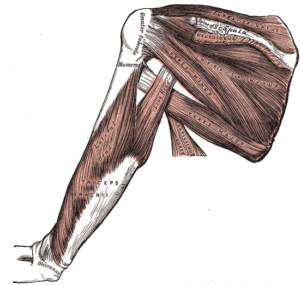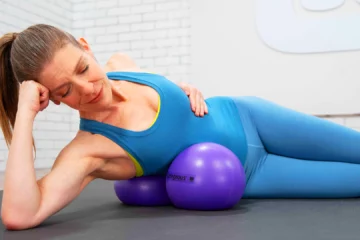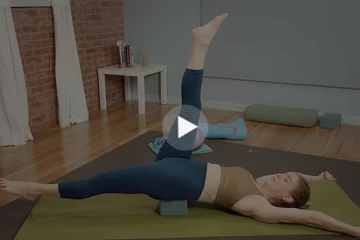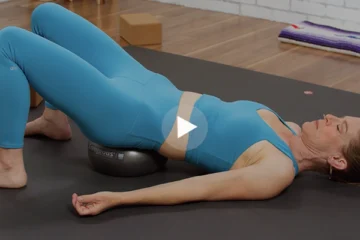
Do you want to soar through the air on a flying trapeze? Or maybe you have a slightly smaller ambition like being able to carry your groceries home without feeling agonizing pain or irritation in your shoulders? Whether performing daredevil stunts or day-to-day activities, your shoulders need to be organized to remain pain-free.
The glenohumeral joint (aka shoulder joint) is a shallow ball and socket joint, which gives the upper arm bone a great deal of mobility. The structure of the joint allows us to move our arms in many different ways but also comes with some downfalls. One being that the joint itself isn’t exceptionally stable – it relies on the musculature surrounding it, particularly the rotator cuff muscles, to stabilize it. If the rotator cuff muscles aren’t strong or are impeded in some way, the integrity of the entire joint is at risk. Another consideration to make when examining the health of the shoulder joint is the balance of tension and tonicity amongst the muscles that attach to the bones of the shoulder. For example, a common issue caused by modern conveniences (think hunching over a computer, cell phone use, etc.) is that the chest and anterior arm muscles become tight and stuck while the back and posterior arm muscles become overstretched and weak. This can create an uneven pull on the joint, which consequently creates poor alignment and compensatory patterns in the shoulder and rest of the body.

The particular pattern I described above often results in the head of the humerus (aka upper arm bone) tilting anteriorly. When this occurs, the arm bone is not nestled neatly in the glenoid fossa of the scapula (aka shoulder joint). Instead, it presses forward into the soft tissue, muscle, tendons and ligaments that surround it. This can result in tendonitis, bursitis, impingement, and other related conditions. When “-itis” (aka inflammation) and degradation occur at the joint, the “good jam” (structures like cartilage and bursi, along with vital fluids within the joint) which act to cushion the joint start to wear down. Without this built in cushion system, bones would knock into or grind up against each other, causing deterioration of bone and other soft tissues. This protective cushioning can also be worn down by repetitive stress or an accident or injury. When this happens we run into the “bad jam,” – when bones knock into other bones, ligaments or muscles, causing potential pain and further injury.
What can we do to avoid the bad jam and keep the good jam intact? Yoga Tune Up ® system provides a multitude of ways to create stabilization in the shoulder joint, free up tension in muscles of the chest, back and shoulders and balance the tonicity of the rotator cuff muscles. Come back Friday for my favorite ways to reset and revive the shoulder joint!
Enjoyed this article? Read Get Your Infraspinatus to Work Smarter, Not Harder
Learn more about the shoulder joint and how to heal shoulder pain.












I love that this post focuses on how to undo all the effects of our “bad daily habit” and especially focusing on the shoulders. I personally have this issue on my right shoulder (from texting as well as sleeping on the side). It’s great to know the difference between this “bad” and “good” jam.
Love the illustration of “good jam” vs “bad jam” as well as the explanation of muscle imbalance contributing to rotator cuff dysfunction and wear and tear on cartilage and bursae.
Really interesting article Amanda. This is something I see all the time with my clients, either in both shoulders or one shoulder. Especially the left shoulder in right handed people.
A combination of strengthening and release works seems to give positive results.
Loved reading this post Amanda! This is a problem that so many of us deal with on a daily basis, how to counteract the affects of modern technology. I learned the YTU posture today Pin the arms on the yogi, where you practice laterally rotating the shoulders while protracting the scapula (having two friends assist you is fun too!) and your post helps me to understand our unhealthy compensation patterns with even more depth and clarity. It’s a good reminder to continually practice stabilizing the shoulders!
I love your outline of the anatomy of function of the shoulder. We live in such a forward folded society, sitting at computer desks, hunched over devices, even watching TV curled up, all of these activities causes the glenohumeral joint to move anteriorly in its fossa, creating a misalignment of a lot of tissues. This creates poor biomechanics of the shoulder and leads to injuries. I’m so thankful to have the YTU balls to offer to my clients!
The more aware I am of posture the more I notice a huge portion of our population, especially adolescents, are developing internally rotated shoulders from those modern conveniences you speak of- too much computer time and texting. Your insight on the structure of the shoulder just shows how vulnerable the shoulder is to injury. I’ll definitely check out those videos on specific methods to correct!
Yoga tune up is good for preventing further injury but mainly you want to try to get the person to correct their daily habits that are causing impingements as well as being aware of their postures to prevent it from reoccurring!
But if course, like mentioned, we want to avoid bone running on bone! Ouch!
There was a student in my yoga class this morning who was complaining of rotator cuff pain that seemed to come out of nowhere and is now seriously affecting her life. It didn’t occur to me until reading this post that her shoulders were fairly hunched forward, so the issue could have been triggered by a constant anterior rotation, as you mentioned. Thank you for that insight – I’m going to use it to try to help her (along with the YTU therapy balls).
Thank you for brining the bursi and cartilages back onto the table for me. I get so caught up in strengthening and relaxing certain areas that I tend to forget about the tissue that I am nourishing and reviving with the balls that I cannot otherwise get to just through stretching or strengthening.
I agree with the hazards of modern life shortening the front body. Yoga Tune Up balls to roll out the pecs is liberating. Too often we forget that the natural position of the humerus is NOT jutting anteriorly. Thank you for the tutorial.
The anterior tilt of the pelvis is pretty much a national crisis! The shoulders can do so much but they are complex and need our attention. The YTU balls really are amazing for this – creating more space in the front and releasing the back. Thanks – great blog.
Great detailed description while keeping it possible for me to understand and put a visual on tightness anteriorly while posterity being overstretched .
Seriously. What happens on Fridays? This is I think the 5th article I’ve read that references a problem without offering solutions, but that tells me to come back on Friday. I appreciate the anatomy description, it’s a well written snapshot of a muscle and a common problem associated with it but this template is annoying.
Great description of the anatomy and how if it doesn’t work together in a healthy way disfunction will creep in. This is a good reminder that our everyday lives can take a toll on our physical structure. A little YTU and some specific intention can start the process of unwinding our junky tissues.
Amanda,
I think this is a great article to “get the ball rolling” so to speak. I have a strong yoga practice and want more mobility in my shoulders, and also want my day to day life activities to be easier. Thankfully I don’t have a full time desk job, but from driving, texting, and a natural rounding of the shoulders I have been aware of the tension I carry. The rolling has helped. I also found another culprit, my lats. If I don’t stretch those muscles as well (at least for me), I don’t get enough rotation in my shoulders. I’ve been using the balls as well as doing PT stretches for my lats and it’s been helping quite a bit. It just goes to show that everything is connected! Thank you for a great piece!
D
I like the description of shoulders being “organized.” This term really gets at the some of the core concepts that YTU represents: there are many components, they are often disorganized (which is the source poor mechanics and resulting pain), and proper corrective exercises (thru strategic massage and stretching) can put the parts into a more effective order.
I’ve had “bad jam” in my right shoulder for a long time now. Before Yoga Tune Up I wasn’t even aware what was happening. The combination of desk sitting, poor arm structure in plank pose and letting my joint get ‘too loose’ during an aerial yoga class left me hurting. There is a BIG difference between extension and over-extension! In Roll Model my favourite self cure for this is Gutter Ball on Page 294 and 295!
Great description of an oh so common problem in our society. I really appreciated the way you dealt with what I find to be quite complex anatomy in clear and discernible images without oversimplifying. So many things can get mucked up when the humerus doesn’t sit right in the glenoid fossa and one problem can so easily lead to another. Thanks for making the complex more clear.
Amanda, That was some good insight on the structure of the shoulder joint. I think it highlights how important it is to keep the shoulder in a good position so it can work properly through its range of motion. Unlike the hip that has a burly ball/socket joint the shoulder cant buffer as much abuse.
TDY
Thank you Amanda for this wonderful article. I like the way you describe the musculature, it’s easy to understand and visualize. Excited to see what technique you suggest tomorrow 🙂
Thank you for the wonderful insight, Amanda. I agree, I’ve had so much stiffness in my shoulders until I started using the YTU balls and poses. One of my favorites to open up my chest is open sesame.
Thank again!